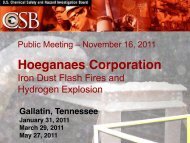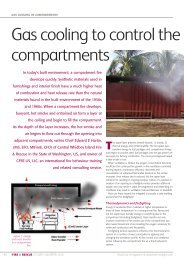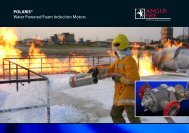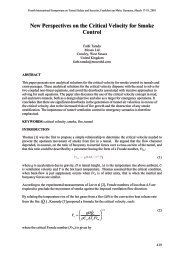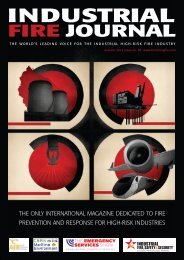aboard FPSO.pdf - Industrial Fire Journal
aboard FPSO.pdf - Industrial Fire Journal
aboard FPSO.pdf - Industrial Fire Journal
You also want an ePaper? Increase the reach of your titles
YUMPU automatically turns print PDFs into web optimized ePapers that Google loves.
Erik Schlytter-Henrichsen of Favuseal explains that FFBS is often<br />
used to protect the steel and GRE piping in water deluge systems:<br />
“You cannot have a fire protection system containing water due to<br />
the risk of corrosion/contamination and subsequent risk of nonfunctioning<br />
nozzles due to corrosion and foreign contamination. So<br />
the challenge is to keep the pipes' temperature low enough until<br />
the water arrives. So Favuseal buys the system time enough to do<br />
its job.” One of the main benefits of Favuseal is that no hazardous<br />
emissions are created when the system is active: “This makes it<br />
possible for responders to tackle the fire with no risk of inhaling<br />
toxic gases,” explains Erik.<br />
Today the company has installations in South Korea (offshore<br />
and onshore), Middle East, the Netherlands (oil and gas GRE pipes<br />
onshore), Denmark, Norway (cooling systems and firefighting<br />
waterpipes), and a major cable manufacturer is using Favuseal to<br />
protect cables in the North Sea and all over the world.<br />
Traditional solutions<br />
Allan Beeston is Global Manager (<strong>Fire</strong> Protection) for Morgan<br />
Thermal Ceramics’ (previously Thermal Ceramics) range of<br />
<strong>Fire</strong>Master products. Thermal Ceramics, headquartered near<br />
Liverpool in the UK, is part of the Morgan Crucible group.<br />
The <strong>Fire</strong>Master fire insulation solution was especially formulated<br />
in the 80s as a lightweight solution against hydrocarbon and jet<br />
fires, and today it is used in various process and fire protection<br />
solutions both onshore and offshore. Key offshore references for<br />
fire pipe protection include Conoco Sanah, Sevan Marine No4,<br />
Sevan Marine 300 No5, Ningaloo Vision, and Marathon Alvheim.<br />
<strong>Fire</strong>Master is a non-combustible flexible matt manufactured from<br />
low biopersistence alkaline earth silicate fibres exonerated from<br />
classification as a carcinogenic material under EU health regulations<br />
Elastopipe projects –<br />
new-builds and refurbishments<br />
In August 2008, <strong>FPSO</strong> Sevan Hummingbird<br />
became the first cylindrical <strong>FPSO</strong> to be<br />
installed in the North Sea. <strong>FPSO</strong> owner<br />
Sevan Marine decided to install Elastopipe<br />
for a number of reasons – not least of which<br />
was the material’s corrosion-free properties.<br />
While the original specification for steel<br />
piping calls for system tests every three<br />
months, Elastopipe’s properties mean that<br />
testing is only required every 24 months –<br />
and this only due to the limiting factor of<br />
peripheral materials.<br />
The fact that no welding or metal cutting is<br />
required for Elastopipe installation meant that no disruptions due to hot work were necessary for<br />
the rest of the <strong>FPSO</strong> Sevan Hummingbird’s installers.<br />
Elastopipe is also experiencing increased take up for major refurbishments of existing stainless<br />
steel fire deluge systems. One such replacement occurred between 2003-2006 on Statoil Hydro’s<br />
Oseberg, which was experiencing corroding welds and pressure leaks. A specifically designed<br />
system was completed by Trelleborg with Aibel Engineering, comprising of 13,000 metres of<br />
Elastopipe, which was installed in a straight one-to-one replacement. Again, no welding or metal<br />
cutting was required.<br />
Hans-Leo Hals of Trelleborg says that with the exception of the Gulf of Mexico, Elastopipe now has<br />
a worldwide presence – not yet the standard of choice on offshore locations but, says Hals,<br />
certainly a material of choice. “It has been time-consuming to certify this type of product because<br />
it is not a standard material, such as steel. However, we have received approval for Elastopipe<br />
installations on a case-by-case basis and hope that it will become a standard material.”<br />
Read our magazine at www.hemmingfire.com FIRST QUARTER 2011 ❘ INDUSTRIAL FIRE JOURNAL ❘ 47



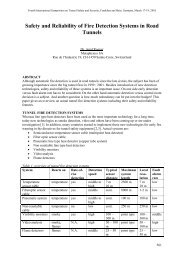
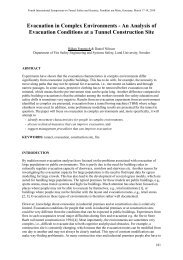

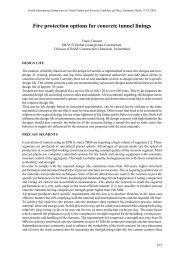
![30-37 TunnelsREV[1]rev.qxd - Industrial Fire Journal](https://img.yumpu.com/22237435/1/184x260/30-37-tunnelsrev1revqxd-industrial-fire-journal.jpg?quality=85)
